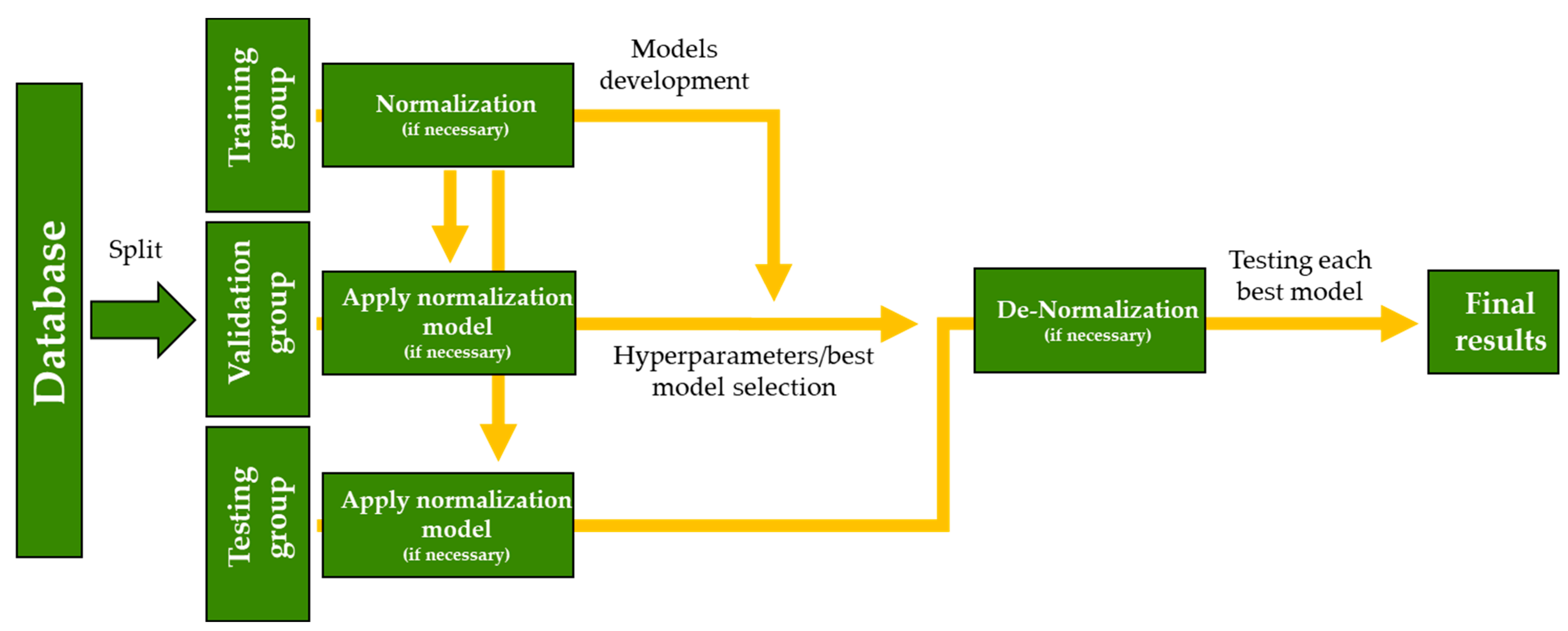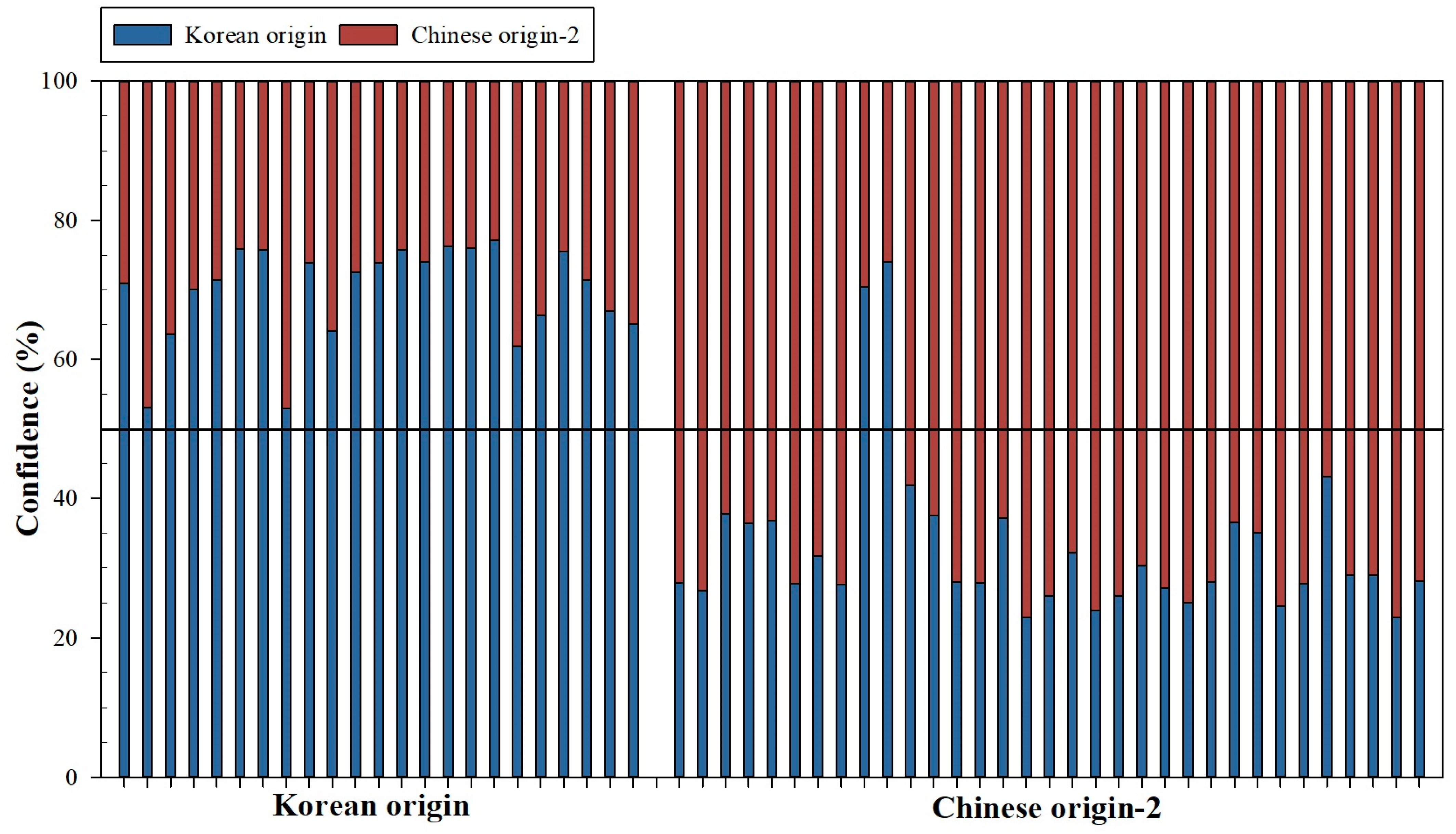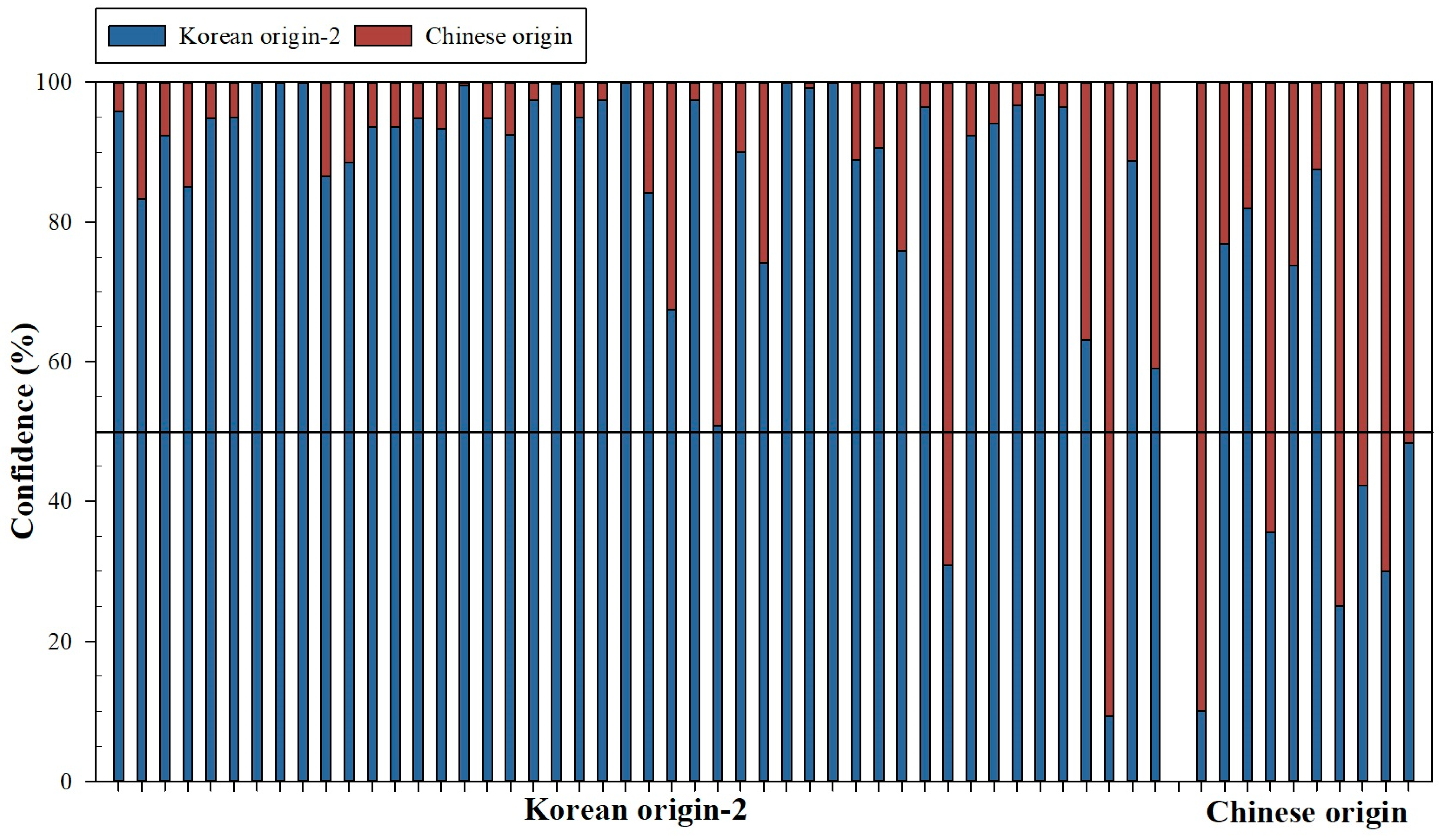Machine Learning Models to Classify Shiitake Mushrooms (Lentinula edodes) According to Their Geographical Origin Labeling
Abstract
:1. Introduction
2. Materials and Methods
2.1. Experimental Data Used
2.2. Machine Learning Developed
2.3. Statistics Measurements
2.4. Software
3. Results and Discussion
3.1. Geographical Origin of Shiitake Mushrooms (Korean Origin, Chinese Origin, and Chinese Inoculated)
3.2. Geographical Origin of Shiitake Mushrooms (Korean Origin and Chinese Origin-2)
3.3. Geographical Origin of Shiitake Mushrooms (Korean Origin-2 and Chinese Origin)
3.4. Final Considerations
- Increase the number of replications for each of the assumptions analyzed (Korean, Chinese, and Chinese inoculated sawdust blocks);
- Analyze different distributions (%) in the training, validation and test groups;
- Study different normalization methods and normalization intervals for the data;
- Analyze different hyperparameters or increase their number, as well as analyze the increase and variation in the range and step of each of them;
- It would also be interesting to analyze the method of selecting the models using factors other than accuracy.
4. Conclusions
Author Contributions
Funding
Institutional Review Board Statement
Informed Consent Statement
Data Availability Statement
Acknowledgments
Conflicts of Interest
References
- Zhang, M.; Zhang, Y.; Zhang, L.; Tian, Q. Chapter Thirteen—Mushroom Polysaccharide Lentinan for Treating Different Types of Cancers: A Review of 12 Years Clinical Studies in China. In Glycans and Glycosaminoglycans as Clinical Biomarkers and Therapeutics—Part B; Zhang, L., Ed.; Academic Press: Cambridge, MA, USA, 2019; Volume 163, pp. 297–328. ISBN 978-0128177402. [Google Scholar]
- Guo, Y.; Sun, K.; Cheng, Y.; Yu, H.; Xie, Y.; Zhang, H.; Yao, W.; Qian, H. Authentication of Shiitake Powder Using HPLC Fingerprints Combined with Chemometrics. Eur. Food Res. Technol. 2022, 248, 1117–1123. [Google Scholar] [CrossRef]
- Tejedor-Calvo, E.; García-Barreda, S.; Sánchez, S.; Marco, P. Effect of Bacterial Strains Isolated from Stored Shiitake (Lentinula edodes) on Mushroom Biodeterioration and Mycelial Growth. Agronomy 2020, 10, 898. [Google Scholar] [CrossRef]
- Chung, I.-M.; Kim, S.-Y.; Han, J.-G.; Kong, W.-S.; Jung, M.Y.; Kim, S.-H. Fatty Acids and Stable Isotope Ratios in Shiitake Mushrooms (Lentinula edodes) Indicate the Origin of the Cultivation Substrate Used: A Preliminary Case Study in Korea. Foods 2020, 9, 1210. [Google Scholar] [CrossRef] [PubMed]
- Ahmad, I.; Arif, M.; Xu, M.; Zhang, J.; Ding, Y.; Lyu, F. Therapeutic Values and Nutraceutical Properties of Shiitake Mushroom (Lentinula edodes): A Review. Trends Food Sci. Technol. 2023, 134, 123–135. [Google Scholar] [CrossRef]
- Avinash, J.; Vinay, S.; Jha, K.; Das, D.; Goutham, B.S.; Kumar, G. The Unexplored Anticaries Potential of Shiitake Mushroom. Pharmacogn. Rev. 2016, 10, 100–104. [Google Scholar] [CrossRef]
- Roszczyk, A.; Turło, J.; Zagożdżon, R.; Kaleta, B. Immunomodulatory Properties of Polysaccharides from Lentinula edodes. Int. J. Mol. Sci. 2022, 23, 8980. [Google Scholar] [CrossRef]
- Rahman, M.A.; Abdullah, N.; Aminudin, N. Lentinula edodes (Shiitake Mushroom): An Assessment of in Vitro Anti-Atherosclerotic Bio-Functionality. Saudi J. Biol. Sci. 2018, 25, 1515–1523. [Google Scholar] [CrossRef]
- Hearst, R.; Nelson, D.; McCollum, G.; Millar, B.C.; Maeda, Y.; Goldsmith, C.E.; Rooney, P.J.; Loughrey, A.; Rao, J.R.; Moore, J.E. An Examination of Antibacterial and Antifungal Properties of Constituents of Shiitake (Lentinula edodes) and Oyster (Pleurotus ostreatus) Mushrooms. Complement. Ther. Clin. Pract. 2009, 15, 5–7. [Google Scholar] [CrossRef]
- Choi, J.-H.; Kim, K.-J.; Kim, S. Purification and Antithrombotic Potential of a Fibrinolytic Enzyme from Shiitake Culinary- Medicinal Mushroom, Lentinus edodes GNA01 (Agaricomycetes). Int. J. Med. Mushrooms 2018, 20, 47–59. [Google Scholar] [CrossRef]
- Cheng, S.; Ranran, L.; Yang, H.; Wang, S.; Lin, R.; Tan, M. Characterisation of Moisture Migration of Shiitake Mushroom (Lentinula edodes) during Storage and Its Relationship to Quality Deterioration. Int. J. Food Sci. Technol. 2020, 55, 2132–2140. [Google Scholar] [CrossRef]
- Ares, G.; Parentelli, C.; Gámbaro, A.; Lareo, C.; Lema, P. Sensory Shelf Life of Shiitake Mushrooms Stored under Passive Modified Atmosphere. Postharvest Biol. Technol. 2006, 41, 191–197. [Google Scholar] [CrossRef]
- Li, M.-Y.; Wang, P.; Wang, J.-Y.; Chen, X.-Q.; Zhao, D.; Yin, D.-X.; Luo, J.; Juhasz, A.L.; Li, H.-B.; Ma, L.Q. Arsenic Concentrations, Speciation, and Localization in 141 Cultivated Market Mushrooms: Implications for Arsenic Exposure to Humans. Environ. Sci. Technol. 2019, 53, 503–511. [Google Scholar] [CrossRef] [PubMed]
- FAO. FAOSTAT. Available online: https://www.fao.org/faostat/en/#data/QC/visualize (accessed on 16 June 2023).
- Chung, I.-M.; Kima, Y.-J.; Moon, H.-S.; Han, J.-G.; Won-Sik Kong, H.; Yarnes, C.T.; Kim, S.-H. Improved Accuracy of Geographical Origin Identification of Shiitake Grown in Sawdust Medium: A Compound-Specific Isotope Model-Based Pilot Study. Food Chem. 2022, 369, 130955. [Google Scholar] [CrossRef] [PubMed]
- Royse, D.J.; Baars, J.; Tan, Q. Current Overview of Mushroom Production in the World. In Edible and Medicinal Mushrooms; Wiley-Blackwell: Hoboken, NJ, USA, 2017; pp. 5–13. ISBN 9781119149446. [Google Scholar]
- Chung, I.-M.; Kim, J.-K.; Han, J.-G.; Kong, W.-S.; Kim, S.-Y.; Yang, Y.-J.; An, Y.-J.; Kwon, C.; Chi, H.-Y.; Yhung Jung, M.; et al. Potential Geo-Discriminative Tools to Trace the Origins of the Dried Slices of Shiitake (Lentinula edodes) Using Stable Isotope Ratios and OPLS-DA. Food Chem. 2019, 295, 505–513. [Google Scholar] [CrossRef] [PubMed]
- Zhang, W.; He, Y.; Wang, L.; Liu, S.; Meng, X. Landslide Susceptibility Mapping Using Random Forest and Extreme Gradient Boosting: A Case Study of Fengjie, Chongqing. Geol. J. 2023, 58, 2372–2387. [Google Scholar] [CrossRef]
- Breiman, L. Random Forests. Mach. Learn. 2001, 45, 5–32. [Google Scholar] [CrossRef]
- Sheykhmousa, M.; Mahdianpari, M.; Ghanbari, H.; Mohammadimanesh, F.; Ghamisi, P.; Homayouni, S. Support Vector Machine Versus Random Forest for Remote Sensing Image Classification: A Meta-Analysis and Systematic Review. IEEE J. Sel. Top. Appl. Earth Obs. Remote Sens. 2020, 13, 6308–6325. [Google Scholar] [CrossRef]
- Naghibi, S.A.; Ahmadi, K.; Daneshi, A. Application of Support Vector Machine, Random Forest, and Genetic Algorithm Optimized Random Forest Models in Groundwater Potential Mapping. Water Resour. Manag. 2017, 31, 2761–2775. [Google Scholar] [CrossRef]
- Chen, J.; Li, K.; Tang, Z.; Bilal, K.; Yu, S.; Weng, C.; Li, K. A Parallel Random Forest Algorithm for Big Data in a Spark Cloud Computing Environment. IEEE Trans. Parallel Distrib. Syst. 2017, 28, 919–933. [Google Scholar] [CrossRef]
- Li, Y.; Zou, C.; Berecibar, M.; Nanini-Maury, E.; Chan, J.C.-W.; van den Bossche, P.; Van Mierlo, J.; Omar, N. Random Forest Regression for Online Capacity Estimation of Lithium-Ion Batteries. Appl. Energy 2018, 232, 197–210. [Google Scholar] [CrossRef]
- Deng, X.; Liu, Z.; Zhan, Y.; Ni, K.; Zhang, Y.; Ma, W.; Shao, S.; Lv, X.; Yuan, Y.; Rogers, K.M. Predictive Geographical Authentication of Green Tea with Protected Designation of Origin Using a Random Forest Model. Food Control 2020, 107, 106807. [Google Scholar] [CrossRef]
- Pal, M.; Parija, S. Prediction of Heart Diseases Using Random Forest. J. Phys. Conf. Ser. 2021, 1817, 012009. [Google Scholar] [CrossRef]
- Suleymanov, A.; Gabbasova, I.; Komissarov, M.; Suleymanov, R.; Garipov, T.; Tuktarova, I.; Belan, L. Random Forest Modeling of Soil Properties in Saline Semi-Arid Areas. Agriculture 2023, 13, 976. [Google Scholar] [CrossRef]
- Lei, T.M.T.; Siu, S.W.I.; Monjardino, J.; Mendes, L.; Ferreira, F. Using Machine Learning Methods to Forecast Air Quality: A Case Study in Macao. Atmosphere 2022, 13, 1412. [Google Scholar] [CrossRef]
- Tu, J.; Hu, L.; Mohammed, K.J.; Le, B.N.; Chen, P.; Ali, E.; Ali, H.E.; Sun, L. Application of Logistic Regression, Support Vector Machine and Random Forest on the Effects of Titanium Dioxide Nanoparticles Using Macroalgae in Treatment of Certain Risk Factors Associated with Kidney Injuries. Environ. Res. 2023, 220, 115167. [Google Scholar] [CrossRef]
- Lipovina-Božović, M.; Kašćelan, L.; Kašćelan, V. A Support Vector Machine Approach for Predicting Progress toward Environmental Sustainability from Information and Communication Technology and Human Development. Environ. Ecol. Stat. 2019, 26, 259–286. [Google Scholar] [CrossRef]
- Cortes, C.; Vapnik, V. Support-Vector Networks. Mach. Learn. 1995, 20, 273–297. [Google Scholar] [CrossRef]
- Kuo, B.-C.; Ho, H.-H.; Li, C.-H.; Hung, C.-C.; Taur, J.-S. A Kernel-Based Feature Selection Method for SVM With RBF Kernel for Hyperspectral Image Classification. IEEE J. Sel. Top. Appl. Earth Obs. Remote Sens. 2014, 7, 317–326. [Google Scholar] [CrossRef]
- Li, H. Support Vector Machine. In Machine Learning Methods; Li, H., Ed.; Springer Nature: Singapore, 2023; pp. 127–177. ISBN 978-981-99-3917-6. [Google Scholar]
- Jiang, H.; Rusuli, Y.; Amuti, T.; He, Q. Quantitative Assessment of Soil Salinity Using Multi-Source Remote Sensing Data Based on the Support Vector Machine and Artificial Neural Network. Int. J. Remote Sens. 2019, 40, 284–306. [Google Scholar] [CrossRef]
- Bonah, E.; Huang, X.; Hongying, Y.; Aheto, J.H.; Yi, R.; Yu, S.; Tu, H. Detection of Salmonella Typhimurium Contamination Levels in Fresh Pork Samples Using Electronic Nose Smellprints in Tandem with Support Vector Machine Regression and Metaheuristic Optimization Algorithms. J. Food Sci. Technol. 2021, 58, 3861–3870. [Google Scholar] [CrossRef]
- Hou, X.; Wang, G.; Su, G.; Wang, X.; Nie, S. Rapid Identification of Edible Oil Species Using Supervised Support Vector Machine Based on Low-Field Nuclear Magnetic Resonance Relaxation Features. Food Chem. 2019, 280, 139–145. [Google Scholar] [CrossRef] [PubMed]
- Astray, G.; Soria-Lopez, A.; Barreiro, E.; Mejuto, J.C.; Cid-Samamed, A. Machine Learning to Predict the Adsorption Capacity of Microplastics. Nanomaterials 2023, 13, 1061. [Google Scholar] [CrossRef] [PubMed]
- Houssein, E.H.; Hosney, M.E.; Oliva, D.; Mohamed, W.M.; Hassaballah, M. A Novel Hybrid Harris Hawks Optimization and Support Vector Machines for Drug Design and Discovery. Comput. Chem. Eng. 2020, 133, 106656. [Google Scholar] [CrossRef]
- Almansour, N.A.; Syed, H.F.; Khayat, N.R.; Altheeb, R.K.; Juri, R.E.; Alhiyafi, J.; Alrashed, S.; Olatunji, S.O. Neural Network and Support Vector Machine for the Prediction of Chronic Kidney Disease: A Comparative Study. Comput. Biol. Med. 2019, 109, 101–111. [Google Scholar] [CrossRef] [PubMed]
- Kamuda, M.; Stinnett, J.; Sullivan, C.J. Automated Isotope Identification Algorithm Using Artificial Neural Networks. IEEE Trans. Nucl. Sci. 2017, 64, 1858–1864. [Google Scholar] [CrossRef]
- da Silva, I.N.; Hernane Spatti, D.; Andrade Flauzino, R.; Liboni, L.H.B.; dos Reis Alves, S.F. Artificial Neural Networks Architectures and Training Processes. In Artificial Neural Networks; Springer: Cham, Switzerland, 2017; pp. 21–22. ISBN 978-3-319-43161-1. [Google Scholar]
- Daviran, M.; Shamekhi, M.; Ghezelbash, R.; Maghsoudi, A. Landslide Susceptibility Prediction Using Artificial Neural Networks, SVMs and Random Forest: Hyperparameters Tuning by Genetic Optimization Algorithm. Int. J. Environ. Sci. Technol. 2023, 20, 259–276. [Google Scholar] [CrossRef]
- Moldes, O.A.; Mejuto, J.C.; Rial-Otero, R.; Simal-Gandara, J. A Critical Review on the Applications of Artificial Neural Networks in Winemaking Technology. Crit. Rev. Food Sci. Nutr. 2017, 57, 2896–2908. [Google Scholar] [CrossRef]
- Astray, G.; Mejuto, J.C.; Martínez-Martínez, V.; Nevares, I.; Alamo-Sanza, M.; Simal-Gandara, J. Prediction Models to Control Aging Time in Red Wine. Molecules 2019, 24, 826. [Google Scholar] [CrossRef]
- Schmitt, F.; Banu, R.; Yeom, I.-T.; Do, K.-U. Development of Artificial Neural Networks to Predict Membrane Fouling in an Anoxic-Aerobic Membrane Bioreactor Treating Domestic Wastewater. Biochem. Eng. J. 2018, 133, 47–58. [Google Scholar] [CrossRef]
- Astray, G.; Fernández-González, M.; Rodríguez-Rajo, F.J.; López, D.; Mejuto, J.C. Airborne Castanea Pollen Forecasting Model for Ecological and Allergological Implementation. Sci. Total Environ. 2016, 548–549, 110–121. [Google Scholar] [CrossRef]
- Puga-Gil, D.; Astray, G.; Barreiro, E.; Gálvez, J.F.; Mejuto, J.C. Global Solar Irradiation Modelling and Prediction Using Machine Learning Models for Their Potential Use in Renewable Energy Applications. Mathematics 2022, 10, 4746. [Google Scholar] [CrossRef]
- Chung, I.-M.; Kim, Y.-J.; Kwon, C.; Moon, H.-S.; Han, J.-G.; Kong, W.-S.; Kim, S.-H. An Origin Identification Model for Labeling of Shiitake (Lentinula edodes). npj Sci. Food 2021, 5, 2. [Google Scholar] [CrossRef] [PubMed]
- Wang, Z.; Lai, C.; Chen, X.; Yang, B.; Zhao, S.; Bai, X. Flood Hazard Risk Assessment Model Based on Random Forest. J. Hydrol. 2015, 527, 1130–1141. [Google Scholar] [CrossRef]
- RapidMiner. Random Forest. Available online: https://docs.rapidminer.com/9.10/studio/operators/modeling/predictive/trees/parallel_random_forest.html (accessed on 8 November 2023).
- Olatomiwa, L.; Mekhilef, S.; Shamshirband, S.; Mohammadi, K.; Petković, D.; Sudheer, C. A Support Vector Machine–Firefly Algorithm-Based Model for Global Solar Radiation Prediction. Sol. Energy 2015, 115, 632–644. [Google Scholar] [CrossRef]
- Ji-yong, S.; Xiao-bo, Z.; Xiao-wei, H.; Jie-wen, Z.; Yanxiao, L.; Limin, H.; Jianchun, Z. Rapid Detecting Total Acid Content and Classifying Different Types of Vinegar Based on near Infrared Spectroscopy and Least-Squares Support Vector Machine. Food Chem. 2013, 138, 192–199. [Google Scholar] [CrossRef]
- Raghavendra Naganna, S.; Deka, P.C. Support Vector Machine Applications in the Field of Hydrology: A Review. Appl. Soft Comput. 2014, 19, 372–386. [Google Scholar] [CrossRef]
- Hsu, C.-W.; Chang, C.-C.; Lin, C.-J. A Practical Guide to Support Vector Classification. Available online: https://www.csie.ntu.edu.tw/~cjlin/papers/guide/guide.pdf (accessed on 17 October 2022).
- Hategan, A.R.; Puscas, R.; Cristea, G.; Dehelean, A.; Guyon, F.; Molnar, A.J.; Mirel, V.; Magdas, D.A. Opportunities and Constraints in Applying Artificial Neural Networks (ANNs) in Food Authentication. Honey—A Case Study. Appl. Sci. 2021, 11, 6723. [Google Scholar] [CrossRef]
- Castelli, M.; Vanneschi, L.; Largo, Á.R. Supervised Learning: Classification. In Encyclopedia of Bioinformatics and Computational Biology; Ranganathan, S., Gribskov, M., Nakai, K., Schönbach, C., Eds.; Academic Press: Oxford, UK, 2019; pp. 342–349. ISBN 978-0-12-811432-2. [Google Scholar]
- Cohen, J. A Coefficient of Agreement for Nominal Scales. Educ. Psychol. Meas. 1960, 20, 37–46. [Google Scholar] [CrossRef]
- Landis, J.R.; Koch, G.G. The Measurement of Observer Agreement for Categorical Data. Biometrics 1977, 33, 159–174. [Google Scholar] [CrossRef] [PubMed]




| Train | Validation | Training + Validation | Testing | |||||
|---|---|---|---|---|---|---|---|---|
| Model | Accuracy | Kappa | Accuracy | Kappa | Accuracy | Kappa | Accuracy | Kappa |
| RF | 0.971 | 0.954 | 0.940 | 0.908 | 0.959 | 0.936 | 0.839 | 0.742 |
| SVM | 0.993 | 0.988 | 0.928 | 0.890 | 0.968 | 0.951 | 0.857 | 0.774 |
| ANNR | 0.971 | 0.954 | 0.940 | 0.908 | 0.959 | 0.936 | 0.857 | 0.774 |
| Testing | All Data | All Data * | ||||||||
|---|---|---|---|---|---|---|---|---|---|---|
| Predicted | Predicted | Predicted | ||||||||
| KO | CO | Ci | KO | CO | Ci | KO | CO | Ci | ||
| True | KO | 23 | 0 | 0 | 123 | 1 | 1 | 114 | 8 | 3 |
| CO | 2 | 6 | 2 | 6 | 49 | 5 | 4 | 26 | 30 | |
| Ci | 3 | 2 | 18 | 3 | 2 | 88 | 2 | 13 | 78 | |
| Train | Validation | Training + Validation | Testing | |||||
|---|---|---|---|---|---|---|---|---|
| Model | Accuracy | Kappa | Accuracy | Kappa | Accuracy | Kappa | Accuracy | Kappa |
| RF | 0.986 | 0.971 | 0.976 | 0.950 | 0.982 | 0.964 | 0.929 | 0.856 |
| SVM | 0.993 | 0.986 | 0.988 | 0.975 | 0.991 | 0.982 | 0.964 | 0.927 |
| ANNR | 0.986 | 0.971 | 0.976 | 0.951 | 0.982 | 0.964 | 0.893 | 0.787 |
| SVM Model | RF Model | ||||||||||||
|---|---|---|---|---|---|---|---|---|---|---|---|---|---|
| Testing | All Data | All Data * | Testing | All Data | All Data * | ||||||||
| Predicted | Predicted | Predicted | Predicted | Predicted | Predicted | ||||||||
| KO | CO-2 | KO | CO-2 | KO | CO-2 | KO-2 | CO | KO-2 | CO | KO-2 | CO | ||
| True | KO | 23 | 0 | 124 | 1 | 113 | 12 | 44 | 2 | 216 | 2 | 208 | 10 |
| CO-2 | 2 | 31 | 3 | 150 | 6 | 147 | 4 | 6 | 10 | 50 | 40 | 20 | |
| Train | Validation | Training + Validation | Testing | |||||
|---|---|---|---|---|---|---|---|---|
| Model | Accuracy | Kappa | Accuracy | Kappa | Accuracy | Kappa | Accuracy | Kappa |
| RF | 0.986 | 0.954 | 0.952 | 0.869 | 0.973 | 0.919 | 0.893 | 0.604 |
| SVML | 0.971 | 0.906 | 0.940 | 0.843 | 0.959 | 0.880 | 0.875 | 0.557 |
| ANNR | 0.978 | 0.930 | 0.940 | 0.843 | 0.964 | 0.894 | 0.893 | 0.635 |
Disclaimer/Publisher’s Note: The statements, opinions and data contained in all publications are solely those of the individual author(s) and contributor(s) and not of MDPI and/or the editor(s). MDPI and/or the editor(s) disclaim responsibility for any injury to people or property resulting from any ideas, methods, instructions or products referred to in the content. |
© 2024 by the authors. Licensee MDPI, Basel, Switzerland. This article is an open access article distributed under the terms and conditions of the Creative Commons Attribution (CC BY) license (https://creativecommons.org/licenses/by/4.0/).
Share and Cite
Rodríguez-Fernández, R.; Fernández-Gómez, Á.; Mejuto, J.C.; Astray, G. Machine Learning Models to Classify Shiitake Mushrooms (Lentinula edodes) According to Their Geographical Origin Labeling. Foods 2024, 13, 2656. https://doi.org/10.3390/foods13172656
Rodríguez-Fernández R, Fernández-Gómez Á, Mejuto JC, Astray G. Machine Learning Models to Classify Shiitake Mushrooms (Lentinula edodes) According to Their Geographical Origin Labeling. Foods. 2024; 13(17):2656. https://doi.org/10.3390/foods13172656
Chicago/Turabian StyleRodríguez-Fernández, Raquel, Ángela Fernández-Gómez, Juan C. Mejuto, and Gonzalo Astray. 2024. "Machine Learning Models to Classify Shiitake Mushrooms (Lentinula edodes) According to Their Geographical Origin Labeling" Foods 13, no. 17: 2656. https://doi.org/10.3390/foods13172656
APA StyleRodríguez-Fernández, R., Fernández-Gómez, Á., Mejuto, J. C., & Astray, G. (2024). Machine Learning Models to Classify Shiitake Mushrooms (Lentinula edodes) According to Their Geographical Origin Labeling. Foods, 13(17), 2656. https://doi.org/10.3390/foods13172656







